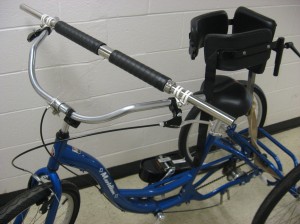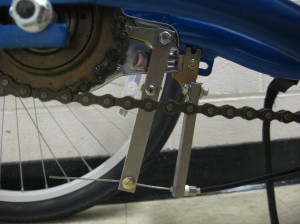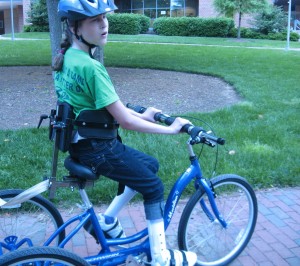Designer: Frances Low
Client Coordinator: Rachel Sellinger, PT
INTRODUCTION
Our client is a teenage girl with athetoid cerebral palsy (CP). She enjoys riding her tricycle in the neighborhood. She rides an adult tricycle, the Schwinn Meridian, and her family attached a hip brace for extra support and a pair of adaptive foot cups to keep her feet on the pedals. However, she is not able to use the conventional hand brakes because she has difficulty reaching, grasping, and engaging them. As a result, someone else must run along side of the tricycle, holding a strap attached to the frame, and stop her by pulling on the strap. This compromises her independence.
We have developed a custom braking system that allows the client to brake independently. It consists of a rotating handlebar that the client twists forward to engage the brakes, and an extended lever arm on the rear band braking system to reduce the force that she needs to apply for braking. The client can use the custom handlebar for both steering and braking, and she does not need to change her hand position to engage the brakes.
http://www.youtube.com/watch?v=C7VM92pb9oY
SUMMARY OF IMPACT
The custom braking system allows the client to brake her tricycle independently using a rotary hand motion instead of using the conventional brake levers. She can apply the brakes without lifting her hands from the handlebar or changing her grip. Twisting forward with her hands applies the brakes and twisting backwards disengages the brakes. True to the intended design, the principles behind the custom brake system are simple and easy for the client to use. As quoted by her mother, “It will be so good for [her] to be able to ride her trike…without having someone run behind with a rope to brake for her.”
TECHNICAL DESCRIPTION
The Schwinn Meridian tricycle has a “cruiser” style handlebar, and our custom handlebar is clamped horizontally to it on both the left and right sides. The custom handlebar consists of two concentric cylinder tubes, made of stainless steel. The outer cylinder is the rotating cylinder that the client holds and uses for steering and brake activation. The inner cylinder is the stationary support shaft. It mounts to the existing tricycle handlebar, and it provides an axis of rotation for the rotating cylinder.
The rotating cylinder has 1.5” outer diameter (OD). It rides on and contacts the support shaft (1” OD) only on its ends, which are capped with custom-made Teflon bushings. The Teflon provides a bearing surface with low friction and prevents binding between the two cylinders. Two shaft collars around the support shaft prevent lateral movements of the rotating cylinder. Halfway down the length of the rotating cylinder, two holes were drilled 45º apart to secure one end of the brake cable. The brake cable is threaded into the cylinder through one hole and threaded out of the cylinder through the second hole. The stopper on the brake cable end is larger than the drilled holes and, therefore, secures the cable to the cylinder. The holes were drilled 45º apart so that the cable running inside the cylinder would not touch and abrade the support shaft. Non-adhesive foam strips are wrapped around the cylinder as hand grips; the area surrounding the secured brake cable end is left unwrapped.
The support shaft is three feet long, which is about twice as long as the rotating cylinder. The rotating cylinder is positioned in the middle of the support shaft such that equal lengths of the support shaft are exposed on either side. A metal bracket with an adjusting barrel is attached to front of the existing handlebar to fasten the brake cable housing to the tricycle frame and to allow the brake cable to be pulled. The custom handlebar is mounted to the existing handlebar frame using eight loop clamps that are lined with silicone to ensure a secure grip. End caps are fitted over the ends of the support shaft and existing handlebar as a safety feature. Polyester Velcro straps are wrapped around the clamps to cover sharp edges.
When the client twists the rotating handlebar, it pulls on the brake cable, which then pulls on a lever arm that engages the band brakes. We provided mechanical advantage by with a new lever that’s 2.5 times the length of the original one, which amplifies the applied force by 2.5 times. The extension is a bracket made of stainless steel with three holes drilled along the bracket. The top two adjacent holes are used to attach the extension to the lever to ensure a firm connection. Once attached to the lever, the extension protrudes downwards towards the ground. A brake cable anchor bolt is inserted in the third hole, closest to the ground, to fasten the end of the brake cable. Another metal bracket is placed relatively parallel to the lever extension and is secured to the tricycle frame. This bracket is thicker than the extension bracket to avoid flexure. An adjusting barrel is fitted to this bracket and keeps the cable housing in place.
Total cost of the project is approximately $300.






2 Comments
Well done, Francis and Rachel of UNC REDP. Appears to be a simple yet elegant solution. $300 doubles the price of a base Meridian trike, but still less than other “special needs” equipment accessories. Wondering if you have any user review after a long time of use, say 12 months or 250 – 500 miles?
Regards, Tom “TrikeMan” Soder, Wilmington Island, GA
Thanks for your feedback! Sorry, I do not have a user review after long term use.